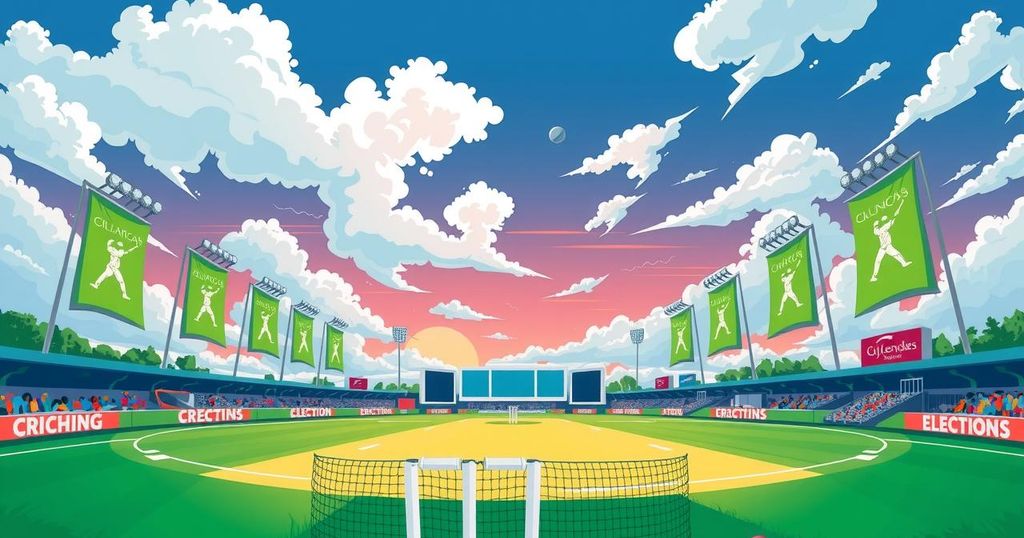Candidates Revealed for Cricket’s All-Important Chief Executives’ Committee Election
Eight candidates are contesting three Associate Member spots in the upcoming CEC election, which occurs on July 17 during the ICC AGM in Singapore. Incumbent Sumod Damodar seeks re-election, while notable figures such as Tim Cutler and Sankar Renganathan join the fray. The CEC plays a key role in cricket’s global governance amidst shifting power dynamics. Concerns continue regarding the welfare of smaller cricket nations amid India’s increasing influence.
The upcoming election for the Chief Executives’ Committee (CEC) of cricket will witness eight candidates competing for three significant Associate Member positions. This election is taking place amidst shifting dynamics among cricket’s governing elites. Nominations closed on June 17, with voting scheduled for July 17, coinciding with the International Cricket Council’s (ICC) Annual General Meeting in Singapore.
Among the contenders is incumbent Sumod Damodar from Botswana, who will seek re-election. Notably absent from the race are Rashpal Bajwa from Canada and Umair Butt from Denmark, who have opted out. High-profile candidates like former Hong Kong chief Tim Cutler, representing Vanuatu, and past USA cricket administrator Sankar Renganathan from Sierra Leone are also in the mix. Other candidates include Gurumurthy Palani from France, Stella Siale from Samoa, Gurdeep Klair from Canada, Anuraag Bhatnagar from Hong Kong, and Sarah Gomersall from Jersey.
The CEC’s role is crucial in promoting and regulating cricket globally, particularly at the international level. For many Associate chiefs, being part of this committee is a valuable opportunity to engage with leaders from the Full Member nations, often serving as a launchpad to positions within the ICC board where critical decisions are made. As power consolidates around mighty India — especially with Jay Shah as the ICC chair and Sanjog Gupta stepping in as chief executive — there are growing concerns for smaller cricket nations, particularly Associates, which generally receive less funding and limited opportunities compared to the established Full Members.
Notably, the Indian cricket board commands the largest share in the ICC’s revenue distribution model, accounting for nearly 38.5 percent, which translates to around $600 million, overshadowing the meager two percent disbursed among its 96 Associate counterparts. There is a substantial reshaping likely for the CEC, with various prominent cricket figures vying for positions.
Damodar, boasting a wealth of experience from three prior terms on the CEC, returned last year following Mubashshir Usmani’s election to the ICC board. He has been a vocal advocate for initiatives like reviving the Afro-Asia Cup and pushing for more marquee events dedicated to Associate nations. Damodar is also keen on establishing a new high-performance program that previously existed for over 15 years before being shelved. This updated program would involve smaller Full Members such as Ireland, Afghanistan, and Zimbabwe, collaborating with top Associates to foster player development and professional administrative structures.
“There are many things that are currently on the cards and of agreed upon but not put into place, like the high performance programme,” said Damodar. He further pointed out the pressing need to address on-field issues, especially better pathways for umpires and clearer procedures for assessing suspect bowling actions.
Renganathan stands out as a wildcard, with a reputation for critiquing USA Cricket’s recent struggles to adhere to ICC Associate membership requirements. While busy in his efforts to uplift cricket in Sierra Leone, a nation that suffered from a brutal civil war, he remains an active figure in cricket governance, previously running unsuccessfully in last year’s ICC board election for Associate Member Directors. “I want to make sure we have the right people sitting in the room, so that the 96 countries are properly voiced,” he emphasized, highlighting the need for transparency and equitable funding throughout the cricketing landscape.
Voting will involve representatives from 40 Associate Members alongside five regional representatives covering the Americas, Asia, Europe, East Asia-Pacific, and Africa, each selecting one candidate. ICC regulations stipulate that candidates must be current or past ICC directors or representatives from an Associate Member. Newly elected members will serve a two-year term and participate in the Associate Member Committee, playing a pivotal role in governance at the Associate level.
The upcoming CEC election is set to be a pivotal moment for cricket governance, particularly for Associate Members who are vying for greater representation and support. With seasoned veterans and newcomers entering the fray, the outcome could significantly reshape the future of cricket development worldwide. Observers will be keen to see how this reshuffling of leadership affects the dynamics among cricket’s governing bodies, especially when funding and support for smaller nations are at stake.
Original Source: www.forbes.com




Post Comment